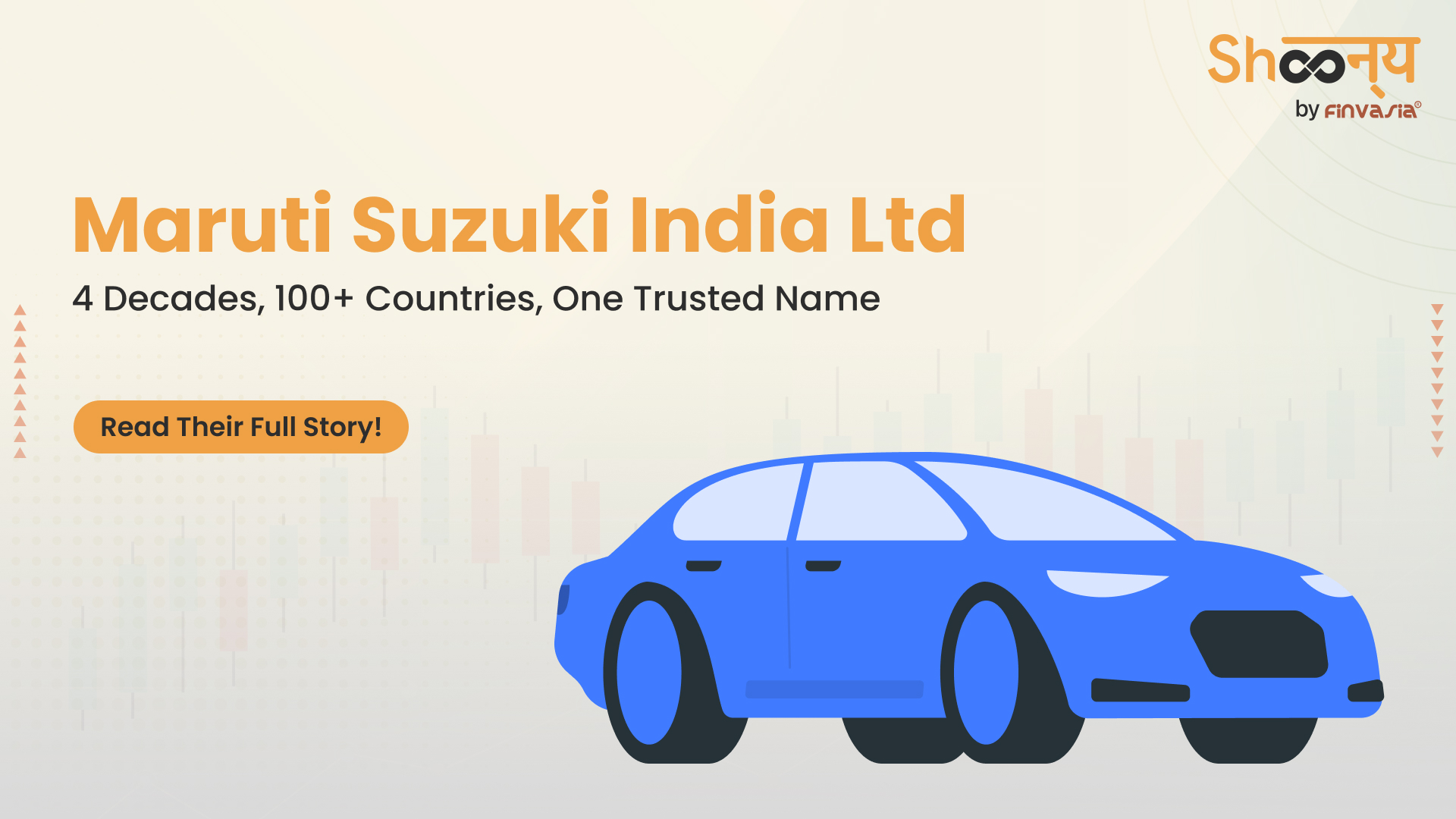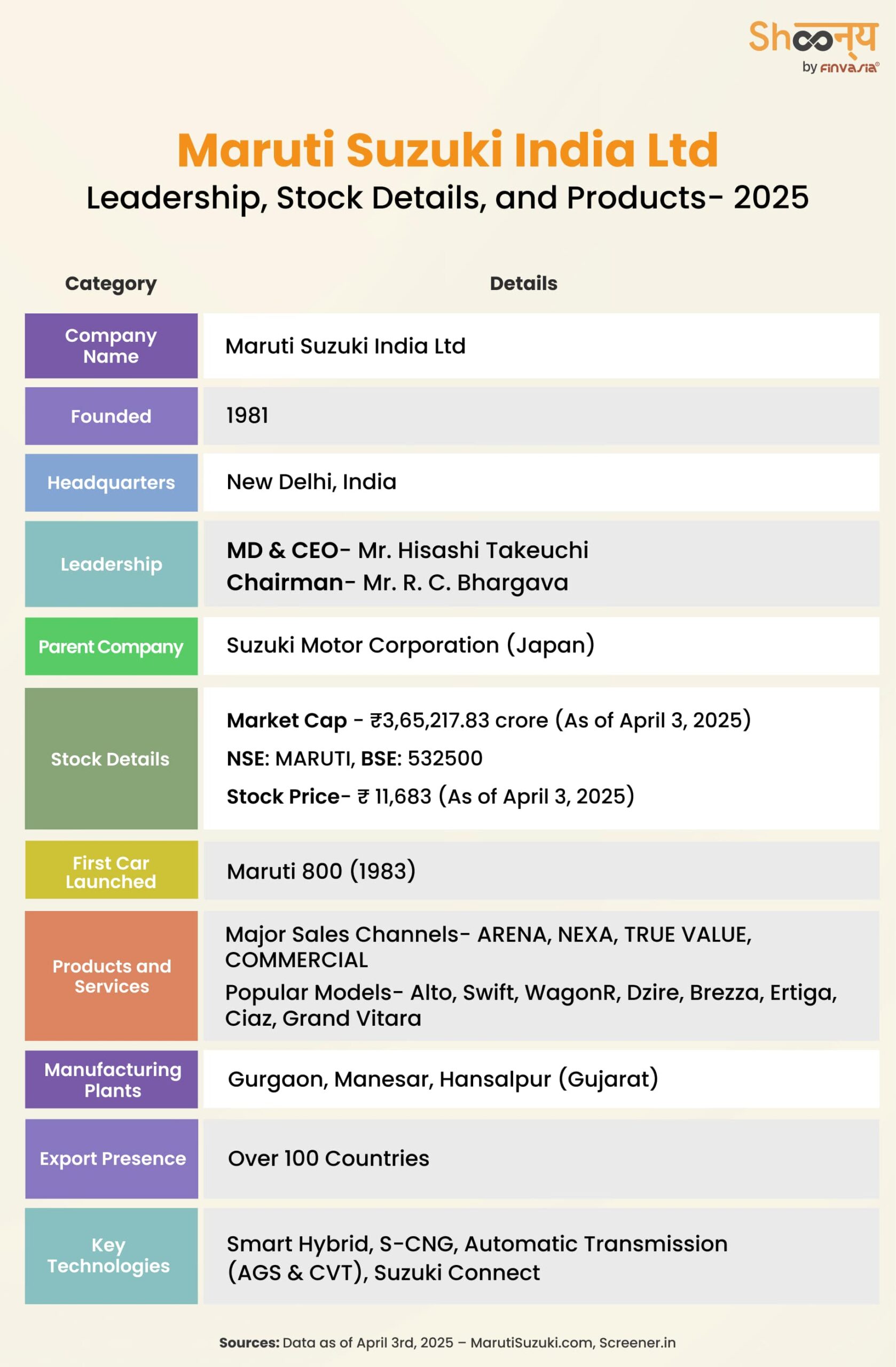From Maruti 800 to Brezza: Maruti Suzuki India Ltd’s History

In the early 1980s, owning a car in India was a distant dream. Then came a turning point in India’s automotive history. A government-backed dream to build an affordable car became a reality when Maruti Suzuki India Ltd arrived.
From the busy Indian city streets to village roads, the brand became a household name. Maruti 800 became the reason of putting millions of Indians behind the wheel for the first time. This happened at a time when most vehicles were either too expensive or not suited for the common man. No one knew that this would become a milestone moment for Indians.
Thus, Maruti Suzuki stepped in, changing the face of Indian roads forever.
For generations, Maruti Suzuki has been a part of our growing-up stories. As of April 3rd, 2025, Maruti Suzuki stands as the leading name among the top constituents of the Nifty Auto Index by market cap.
But how did it all begin?
Let’s take a ride through the history of India’s favorite car company- Maruti Suzuki India Ltd.
Maruti Suzuki History
It all started in 1981 when the Government of India joined hands with Suzuki, a Japanese automobile giant. Their goal was just one!
They wanted create a car that was affordable, reliable, and fuel-efficient. The result was the legendary Maruti 800.
Want to buy Maruti Suzuki stock? Do it with a free Demat account.
The Beginnings: Pre-Suzuki Era
You would be amazed to know that the roots of Maruti Suzuki trace back to the vision of Sanjay Gandhi, son of then-Prime Minister Indira Gandhi.
In the early 1970s, India was searching for a small, affordable car. Sanjay Gandhi, passionate about automobiles, trained at Rolls-Royce in the UK and returned with a dream to manufacture India’s own “people’s car.”
In September 1970, the government issued a letter of intent to produce 50,000 cars per year. By August 1971, Maruti Motors Limited was officially formed, with Sanjay Gandhi as its first managing director.
The company acquired land in Gurgaon to set up a factory, and a prototype was ready by 1972. However, despite initial promise, the project faced several setbacks. The prototype failed feasibility tests, and production never took off as planned. By March 1976, only 21 units had been produced.
The project suffered further complications when Sanjay Gandhi became politically active during the Emergency. Following Indira Gandhi’s defeat in the 1977 elections, the company faced an uncertain future.
It was eventually dissolved in 1978. However, Indira Gandhi’s return to power in 1980 revived the project.
Result?
The government took control of Maruti.
The Suzuki Partnership
The Indian government decided to have a collaboration with an experienced manufacturer. With this, negotiations with Suzuki Motor Corporation began in April 1982, and by October 1982, a joint venture agreement was signed.
Suzuki initially took a 26% stake, which was later increased to 40% after five years, as per the agreement.
Maruti was granted permission to import fully assembled Suzuki vehicles for the first two years while gradually increasing local manufacturing. Some domestic manufacturers opposed this move, but the government made tariff adjustments to boost sales.
The First Maruti Suzuki Cars
Production officially began in December 1983 with the launch of the Maruti 800, based on the Suzuki Fronte/Alto. This small, affordable car changed India’s automotive industry forever. The following year, the company introduced the Maruti Van with the same three-cylinder engine as the 800.
Maruti initially planned to produce 20,000 cars in the first year, increasing to 40,000 in the second year. However, demand exceeded all expectations.
Within the first year, 120,000 bookings flooded in.
This was way too much for the company to deal with.
In 1985, Maruti launched the Suzuki SJ410-based Gypsy, a 970cc four-wheel-drive off-road vehicle. The company hit a major milestone when it rolled out its 100,000th car in 1987.
By 1992, Suzuki increased its equity in Maruti to 50%, strengthening its hold on the company. The partnership led to the introduction of several new models, including the Maruti 1000 (later upgraded to Esteem), the Zen in 1993, and the Omni van.
The Indian government gradually reduced its stake in the company. By 2003, Maruti was a public company, and in 2007, Suzuki acquired full ownership, making it a subsidiary.
Maruti Suzuki continued to expand its portfolio with new models like the Swift (2005), Alto, Dzire, and WagonR. The introduction of the premium NEXA showroom in 2015 signaled the company’s shift towards premium Maruti Suzuki products.
As the years passed, Maruti Suzuki index continued to grow.
From the fuel-efficient Alto to the stylish Swift and the spacious Ertiga, Maruti Suzuki was shaping lifestyles.
One of the biggest reasons behind Maruti Suzuki’s success was its understanding of the Indian customer.
The company ensured that spare parts were easily available, service centers were widespread, and mileage was always a priority. Indians love a car that doesn’t burn a hole in their pocket, and Maruti Suzuki delivered it all!
Even now, you would see a typical Indian family prefer Maruti products because of all the services available in India.
With time, competition grew, and new players entered the market.
But Maruti Suzuki remained the top choice.
Why?
Because it evolved with the times, it introduced automatic transmissions, CNG models, and even hybrid technology.
Today, almost every Indian family has a Maruti Suzuki story. Whether it’s the first family road trip in a WagonR, the first car gifted to a college graduate, or the reliable Swift that has been part of countless journeys!
About Maruti Suzuki Stock, Products and Services
Maruti Suzuki India Limited, commonly known as Maruti Suzuki, is India’s leading automobile manufacturer. It was established in 1981 as Maruti Udyog Limited. The organisation began as a joint venture between the Government of India and Suzuki Motor Corporation of Japan.

Maruti Suzuki operates through multiple sales channels to enhance customer experience.
The company has introduced several technological advancements, including:
- Smart Hybrid Technology: It enhances fuel efficiency and reduces emissions by integrating an electric motor with the conventional engine.
- S-CNG Technology: This offers factory-fitted CNG vehicles, providing an eco-friendly and cost-effective alternative fuel option.
- Automatic Transmission: Provides a convenient driving experience with options like Auto Gear Shift (AGS) and Continuous Variable Transmission (CVT).
- Suzuki Connect: A telematics solution that offers features like vehicle tracking, driving behavior analysis, and emergency alerts.
Maruti Suzuki Leasing: A New Way to Drive Without Ownership Worries
Today, Maruti Suzuki is reimagining car ownership with Maruti Suzuki Leasing, offering a smarter and more flexible way to drive without the long-term commitment of buying.
Maruti Suzuki Leasing aims to remove these burdens, making mobility seamless and stress-free.
Corporate leasing allows companies to provide cars for employees without the financial strain of outright purchases. It also offers tax benefits and simplifies fleet management.
For individuals who love driving a brand-new car but prefer flexibility, retail leasing is an ideal choice.
Maruti Suzuki Insurance: A Complete Protection Plan
Unlike generic insurance plans, Maruti Suzuki Insurance Broking is designed exclusively for Maruti Suzuki car owners. It provides an easy experience from purchase to claim settlement, ensuring maximum convenience for all.
Maruti Suzuki’s Green Drive: A Commitment to a Sustainable Future
With millions of vehicles on the road, the environmental impact of automobiles is undeniable. The company follows the globally recognised ISO 14001 standard, ensuring that its plants and suppliers meet the highest environmental standards. Additionally, it follows the Biomedical Waste Management Rules, 2016, ensuring responsible waste disposal.
Maruti Suzuki Revenue Milestones in 2025: A Year of Record-Breaking Achievements
From crossing the 2 million annual sales milestone for the second consecutive year to introducing cutting-edge technology in commercial vehicles, the company continues to drive India’s mobility revolution.
- Highest-ever annual domestic sales: 1,795,259 units
- Highest-ever annual exports: 332,585 units, marking a 17.5% increase over the previous year
- Maruti Suzuki Super Carry became the first model in its segment to feature Electronic Stability Program (ESP®).
- The company partnered with the Gurugram Metropolitan Development Authority (GMDA) and Utkrisht Society for Safe Haryana to implement an Integrated Traffic Management System, aiming for safer and smarter urban mobility.
From iconic models like Maruti 800 to modern innovations like Smart Hybrid and Suzuki Connect, Maruti Suzuki has truly transformed how India drives.
Maruti Suzuki India Limited: FAQs
As of April 3, 2025, Maruti Suzuki’s share price is ₹ 11,683.
In the third quarter of the fiscal year 2024-2025, Maruti Suzuki reported net sales of ₹38,492.10 crore, marking a 15.56% year-on-year increase.
Founded on January 24, 1981, as Maruti Udyog Limited, the company began as a joint venture between the Indian government and Suzuki Motor Corporation. The launch of the Maruti 800 in 1983 was the biggest milestone.
Maruti Suzuki offers a wide range of vehicles, including hatchbacks (Alto, Celerio, Swift), sedans (Dzire, Ciaz), SUVs (Vitara Brezza, S-Cross), and multi-purpose vehicles (Ertiga).
Maruti Suzuki’s stock is listed on Indian stock exchanges. As of April 3, 2025, Maruti Suzuki’s share price is ₹ 11,683, and it is a key component of the Nifty Auto Index.
Maruti Suzuki’s product lineup includes Hatchbacks like Alto, Celerio, Swift, Sedans like Dzire, Ciaz, SUVs like Vitara Brezza, and Multi-Purpose Vehicles (MPVs) like Ertiga.
Source: Screener
______________________________________________________________________________________
Disclaimer: Investments in the securities market are subject to market risks; read all the related documents carefully before investing.








